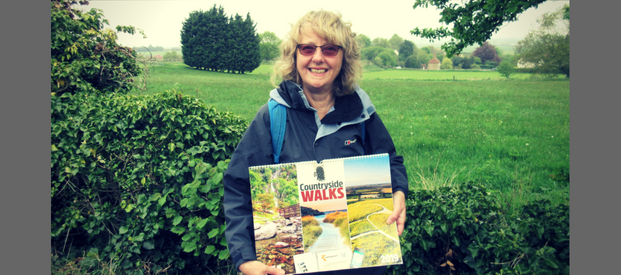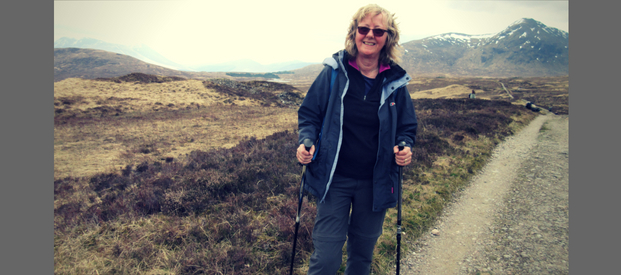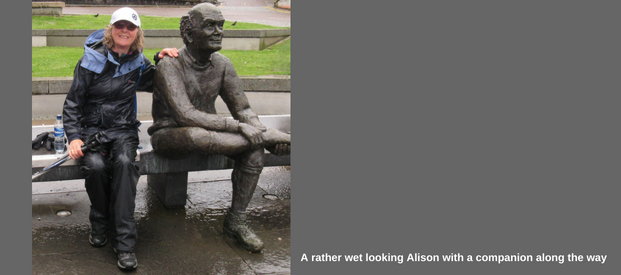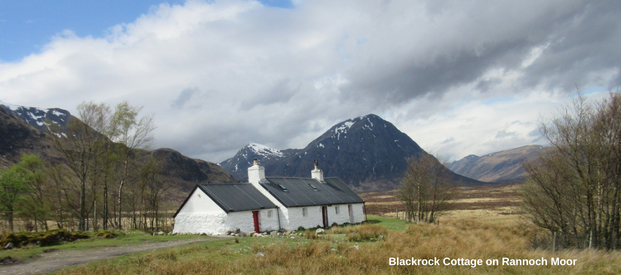Alison Hilton walks The West Highland Way
Fourth generation ‘Rose’ family member Alison Hilton has recently completed a walk of The West Highland Way, following in the footsteps of her late father Dick Rose. Alison has wanted to walk The West Highland Way for several years and after completing the Coast to Coast walk from the west to east coast of northern England in 2016 and the Dales Way from Yorkshire to the Lake District in 2017 she decided that this year was the time to do it.
Alison chose early May so as to avoid the notorious midge season in the Highlands which lasts from June to late August. She decided to walk it alone partly because she couldn’t persuade anyone else to do it with her and partly because she enjoys walking on her own, and knowing from experience that she would meet people to walk with most of the time.
The West Highland Way is extremely popular and is internationally well-known. On her route Alison met walkers from Canada, USA, Australia, Germany, France and Holland and of course the UK, especially Scotland and England. Many of these were carrying their belongings themselves, including camping gear in very large rucksacks, others, had chosen to use one of the many baggage carrying services which carry your luggage between each overnight stop on the route, while you carry a lighter rucksack each day containing essential items.
Part of Alison’s inspiration to walk the West Highland Way was her father, Dick Rose, who completed the walk in 2001. He did this on his own and also did the Coast to Coast walk, again as a solo walker, in 2004. He also did several other long distance walks including the Thames Path and the Ridgeway Path with a group of friends from Colchester Rotary Club to raise money for different charities. Alison and her two brothers joined him for a few days on these walks and Michael Rose (Alison’s cousin), Alison’s brother Phil and other friends also joined Dick for the Three Peaks Charity Challenge, climbing Ben Nevis, Scafell Pike and Snowdon within a 24 hour period – a gruelling feat!
The West Highland Way is Scotland’s first and most famous long distance walk. It covers 96 miles from Milngavie, just north of Glasgow, to Fort William. You walk through the soft lowlands of the Campsie Fells, along the whole length of the rocky shoreline of Loch Lomond, Britain’s largest body of inland water, through Glen Falloch and Strath Fillan, across the wilderness of Rannoch Moor, into the majestic mountain grandeur of Glen Coe, passing Buachaille Etive Mor, the Mamores range and finally ending at Fort William at the foot of Ben Nevis, Britain’s highest mountain. Most people walk from south to north and take between 5-10 days to complete the walk. Alison walked over seven days, doing an average of 15 miles a day, and usually averaging about two miles an hour due to climbing or the rough terrain. Others were taking a bit longer, having a rest day here and there. Most days there was somewhere to stop for refreshment along the way – farms selling food and drink, shops, cafes, pubs – providing a welcome break and the chance to sit down, rest your feet and maybe take off your walking boots for a short while. Every day Alison saw other walkers and would walk a little way with different people, then do a bit more walking on her own.
The West Highland Way is very easy to follow and well-marked with signposts along the whole route. The map and guide book Alison had taken with her stayed in her rucksack the whole time. Another reason for this is that for most of the route it uses old military roads built in the 18th century to move government troops around (to suppress the rebellious Scots!). The highest part of the West Highland Way, the Devil’s Staircase, a zigzag path climbing out of Glen Coe, was built around 1750 by about 450 soldiers, taking huge effort to build in this rugged terrain. There are many historical links along the way to Scottish heroes such as Rob Roy MacGregor, battle sites of the Jacobite Risings and of course, Glen Coe, location of the infamous Massacre of 1692.
The route runs through varied habitats: river valley, lochside, woodland, heath, remote moorland and fells. Bird song surrounds the lone walker and though harder to actually spot them, deer can occasionally be seen in the distance and small mammals might sometimes cross the walker’s path. At this time of year, the trees are only just coming into leaf and primroses and daffodils were in flower along the banks and hillsides while Alison walked the route. Bright yellow gorse stood out along the path side and small wild flowers were springing up in the grass. In the woodland unusual fungi sprouted from the side of tree trunks and the scent of pine trees filled the air.
There is a wide range of overnight accommodation along the way from Bed and Breakfasts, small hotels, guest houses and camping pods at a farm campsite. At the end of each day after having a shower and changing, Alison enjoyed talking to other walkers in the bar and have a meal together. Some people were “wild camping”, which is allowed in a lot of parts of the route, but there are many campsites and youth hostels with very good facilities and in beautiful locations.
The weather was typically Scottish! Whilst most of the UK was experiencing a heatwave over the first May Bank Holiday weekend, it didn’t quite reach that part of the Highlands. Alison only saw the sun on two days of the walk, the rest of the time it was cloudy and overcast. On days 2, 6 and 7, she was walking in the rain most of the day with waterproof trousers and clothing layers really coming into their own.
Alison’s favourite day was walking through Glen Falloch and Strath Fillan in the sunshine and walking across Rannoch Moor to Glen Coe, which has been featured in many calendars, including Countryside Walks and some of our Scottish range over the years. Alison enjoyed doing this part of the route on a clear day with sunny weather and little wind and was able to experience the beauty of this true wilderness. According to her, the hardest parts of the walk were by the side of Loch Lomond along undulating loch shore paths which involved much scrambling up and down rocks made slippery and muddy by the rain and climbing up the Devil’s Staircase in the mist, the highest point on the West Highland Way at 548m.
When we asked Alison if she would do it again, she replied “Maybe, who knows…I would certainly do some parts of it again. It was tough in places and the weather could be unpredictable. My feet survived without any blisters but it was great to take off my boots at the end of each day! I feel proud to have completed this challenge and to have done it on my own, and enjoyed the company of strangers and the scenic grandeur of the Highlands”.













